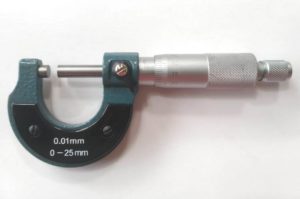A micrometer is one of the linear measuring instruments, provides accuracy down to 1/100 of a millimeter. Even, some of them can reach 1µm accuracy. It’s truly a hand-held tool that you can rely on to measure something very thin or to get more detail about the thickness, length, diameter, and depth of an object.
This resolution was not found overnight. Previously, micrometer has a long story before its design and accuracy get improved to be like we use today. The old-fashioned first standard micrometer could only measure with 0.05mm accuracy.
There is a threaded screw inside the thimble in which is the reason behind the accuracy of the micrometer. This threaded screw is also the answer to how a micrometer works, especially for the mechanical model.
Micrometers are available in different ranges, from 1inch to 6inch. However, the most used provides 1inch (25 mm). The range is the longest distance of a micrometer can measure. Therefore, if the object you are measuring has a thickness of more than 1inch, you have to pick out the other.

In addition, its weight is not like what it seems. Certainly, it’s because of the made-of-steel body. It feels heavy and fantastic. Aside from that, its length is about 20 cm for a mechanical 1-inch range one. It’s very cute to get held by your hand.
Today’s micrometer is commonly empowered by carbide material on the measuring faces (anvil and spindle). It functions to harden the surface, improve accuracy and increase durability. Many old fashioned micrometers may be made of steel on total body. However, since technology develops and people found that carbide is better than steel, the manufacturers then turn over to carbide.
Micrometer Pros and Cons
Undoubtedly, every measuring tool has advantages and disadvantages. For this kind of high precision measuring tool, what are the advantages and disadvantages of a micrometer? Let’s have a look.
Advantages:
- More Accurate Measurements. A micrometer has the ability to measure with extreme accuracy while you can carry it on anywhere you want.
- Compact. In case you have to measure the thickness of a wire, you don’t have to do it in your lab. You just measure it on the site instead. Even though the bench model is also available.
- A Separate Scale is not Required: A micrometer has two scales; a primary scale and a secondary scale. Readings are taken from these scales so there is no need of a separate scale.
- Durable Instrument: Micrometers are manufactured with strong materials. It enables it to last for a long period of time.
- Available in Different Types: They are available in different types so that a different micrometer can be used for a specific purpose.
Drawbacks:
- Limited Range: A micrometer has a limited range, it doesn’t have the capacity to measure for all sorts of objects. They usually have a range of 25mm (1 inch).
- Expensive: Different kinds of micrometer may be required for various tasks and for one micrometer that has good quality can cost expensively as compared to other instruments. However, the accuracy and precision provided are reliable.
- One Type for One Task: A general micrometer which has flat anvil is not recommended to measure a ball-shaped object. Whereas, the V-shape micrometer is more preferable. This can be a problem for some people. A different type of micrometer is needed for a specific task which can end up being a hassle. An operator cannot keep changing instruments again and again.
- Experience is Necessary: It is true that micrometers provide accurate measurements but only an experienced operator can get the required readings. There is a chance of inaccuracy if the operator is not experienced or well-educated in terms of using it.
Micrometer Types
There are numerous types of the micrometer which we can classify based on the dimension to be measured, the reading display model, and anvil types installed to the micrometer for a certain task and need.
Based on the dimension they measure, there are three types: inside, outside, and depth micrometer. The inside is to measure inside diameter. The outside is to measure the outside diameter, thickness, and length. The depth is to measure depth. They all are actually different tool, unlike the caliper where you can find all the function in a single tool.
There are three types based on the reading display: mechanical, dial, and digital micrometer. The digital sometimes uses a vernier scale to get better accuracy. The dial uses dial gauges which are designed in such a way to fit with the micrometer. The last one is the digital micrometer which is the most simple micrometer you can rely on but the price may shock you.
A micrometer is a very specific tool. It is designed to handle a specific task. Therefore, there are various types of micrometer based on the anvil it uses. The most used one is the flat anvil type. This is the micrometer that we recommend to buy first because it can handle most tasks. If you have understood and have good insight about a micrometer, you can the other anvil to get a better experience.
This micrometer topic is a long post and we decide to write it in a separated place. You can read it on our page here.
Micrometer Body Parts
This topic can be found discussed clearly on this page. The body parts of the micrometer are frame, anvil, measuring faces, locking nut, thimble, sleeve, fixed scale, stationary scale, threaded spindle, and ratchet.
Final Thought
Overall, a micrometer is a very recommended tool to use when you have to deal with highly accurate and precise measurement. It’s hand-held and compact so you can carry it on anywhere you want. Although its capability is limited only for specific purpose thus you need more than one tool for different tasks, however, its advantage is very stunning and wonderful for extremely accurate measurement.

